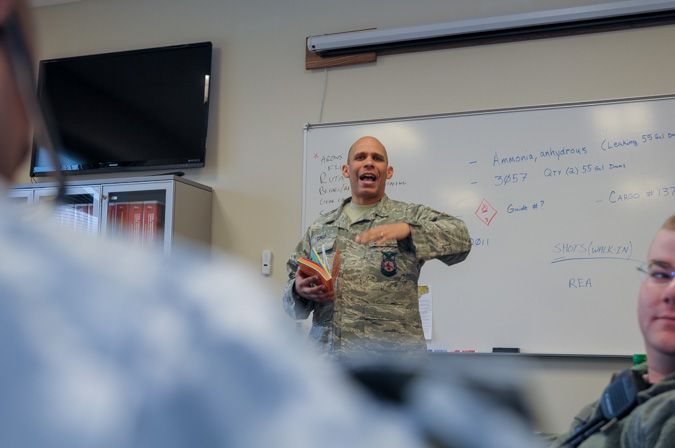MIDDLE RIVER, Md. (Feb. 10, 2014) – On a cold, overcast weekend, the Maryland National Guard’s 231st Chemical Company and 175th Civil Engineering Fire and Emergency Services Flight conducted joint HAZMAT training at Warfield Air National Guard Base in Middle River, Md., on Feb. 8-9, 2014.
“[This is] the first time that we’ve done any joint training with another branch,” said Air Force Master Sgt. Joel McCroy, assistant chief of training for the 175th Civil Engineering Fire and Emergency Services Flight and a former Army infantryman. “Most of our members have deployed to joint bases and worked in a joint environment, so it just made sense to include joint training into what we do.”
The 231st contacted the 175th fire department this past fall about training that could benefit both units. From the beginning, both organizations had to learn a little about each other–different acronyms, ranks and particular ways of doing things. Firefighters got firsthand experience working with the operations order supplied by 231st Chemical Company.
Each day of the weekend’s training consisted of four stations: fixed-wing aircraft decontamination; Single Channel Ground and Airborne Radio System training; troop decontamination using Mission Oriented Protective Posture level 4; and familiarity with the Air Guard’s equipment used to detect chemical, biological and radiological materials.
“The Air National Guard’s fire department here has absolutely been fantastic in accommodating us and making sure that both the Army and the Air Guard get excellent training out of this,” said Army 1st Lt. Kristofer Baumgartner, 231st commander. “This is something that the Soldiers are absolutely looking forward to. They hadn’t had this kind of unique training before, and they’re using this as an opportunity to learn new skills.”
A retired A-10 Thunderbolt II aircraft with a brand new paint job, slotted to be used as a static display, gave the Soldiers a full-sized aircraft to work with. This allowed them to conduct realistic training without taking an aircraft out of operation, freeing it up to do flights and minimizing potential damage.
Although it was a display model, Soldiers still received a safety brief on approaching the aircraft and avoiding its danger zones. Army Staff Sgt. Aaron Edwards, platoon sergeant for DECON Platoon, explained to his group of Soldiers the extreme importance of decontaminating the aircraft’s wheels and areas that the pilots may touch, to allow the aircraft to return to and stay in the fight.
This period of training was also drill weekend for the Maryland Air National Guard. The mechanics were repairing, pilots were flying, the support staff was hard at work, and Airmen, Soldiers, and even the Civil Air Patrol filled the dining facility.
“I hope we can do some more [training] in the future,” said McCroy. “Maybe we can expand it to some other things; we already discussed the possibility of a field exercise in the future.”
Air Force Tech Sgt. Michael Cruz conducts a familiarity course on HAZMAT symbols.
After the joint training proposal received the green light through the respective chains of command, the two organizations moved forward to obtain training areas, schedule events, coordinate training with the 175th Emergency Management, and secure an aircraft from the 175th Maintenance Squadron.
Training in a joint environment allows Service members to build relationships, learn best practices, work with different equipment, and increase specific skills in an unfamiliar environment.
Senior Airmen Joe Galloway, a firefighter, uses the Single Channel Ground and Airborne Radio System to perform a radio communication check.
When asked what he considered the best part of the training, Sgt. Jonny Kincaid, a 4th Platoon section leader in the 231st and member of the chemical strike team for the International Monetary Fund, said, “Seeing some of my colleagues and some of the [junior] enlisted Soldiers get into the suits (JSLIST) and go through everything.”
Team members don MOPP Level 4 or the Joint Service Lightweight Integrated Suit Technology (JSLIST) to carry out their mission. The proper wear of this equipment is vital for completing the mission safely, so team members constantly monitor each other and correct malfunctions.
“I’m pretty knowledgeable in what I do, and [I’m] always into learning other techniques. I’m willing to learn each and every technique I can,” Kincaid added.
Air Force Staff Sgt. Mike Dowling and Airmen Andrea Chaves, both in emergency management, demonstrate the proper wear of some of the equipment that fire fighters wear.
The 175th Civil Engineering Fire and Emergency Services Flight is considered a Prime BEEF civil engineer unit by the Air Force. Nothing to do with steaks, it means Prime Base Engineer Emergency Force, an organization that could be tasked with setting up a bare base.
“Next month we’ll be doing a field training exercise with an active duty unit at Aberdeen Proving Ground,” said Baumgartner. “The following month we’ll be doing an aviation chemical reconnaissance and also a rotary-wing decontamination at the Edgewood Area of Aberdeen Proving Ground with the 29th Combat Aviation Brigade.”
The unit is scheduled to conduct annual training at Muscatatuck Urban Training Center in Indiana, where they will train on a wide range of chemical activities such as decontamination, reconnaissance and working on forward operating bases.
“Whenever we deploy to a combat zone, it’s never what you think it will be. We may be working with the Air Guard, Marine Corps, other units, [or] other countries even,” said Baumgartner. “So, it’s an invaluable asset for us to be able to come out here and join our friends at the Air National Guard and understand how other units do things.”
(By Staff Sgt. Thaddeus Harrington, Maryland National Guard Public Affairs Office)






